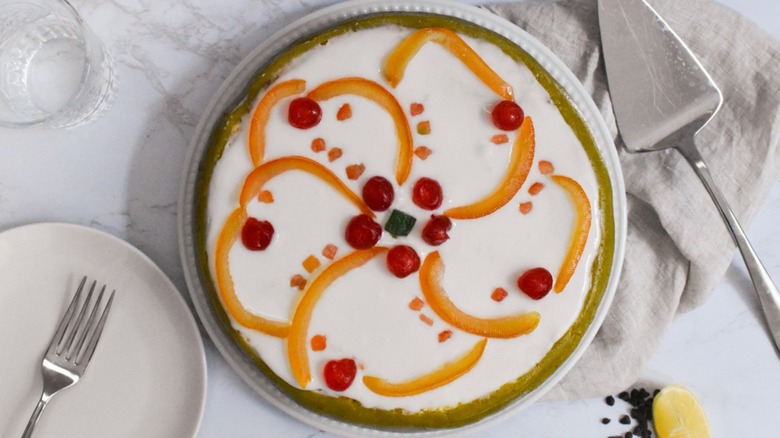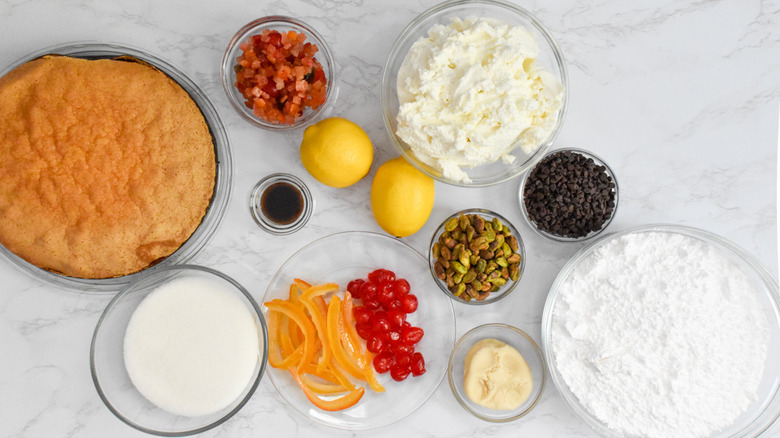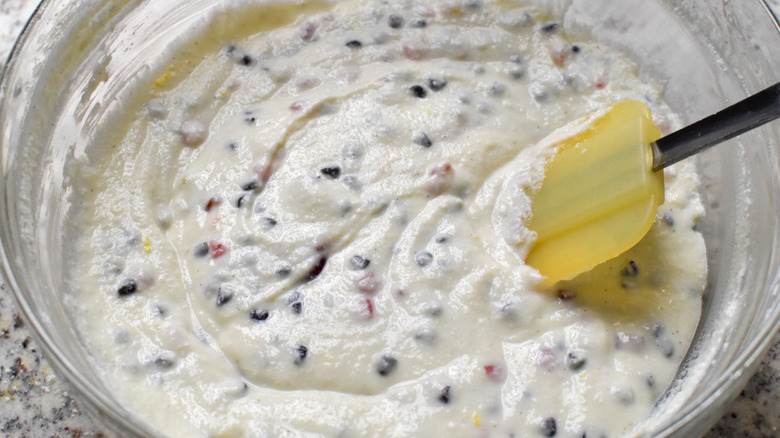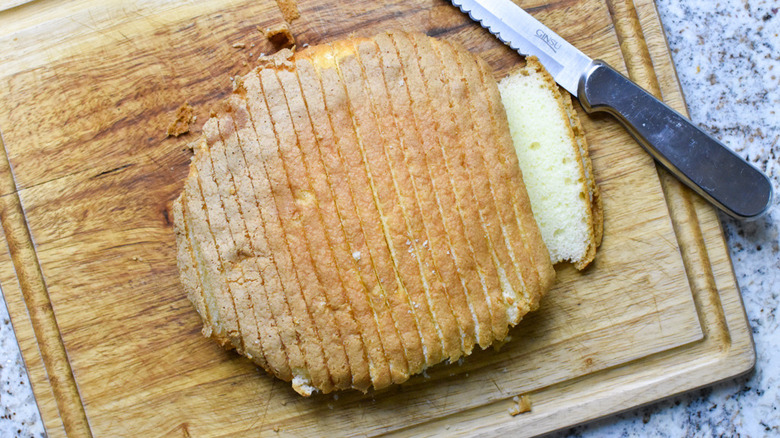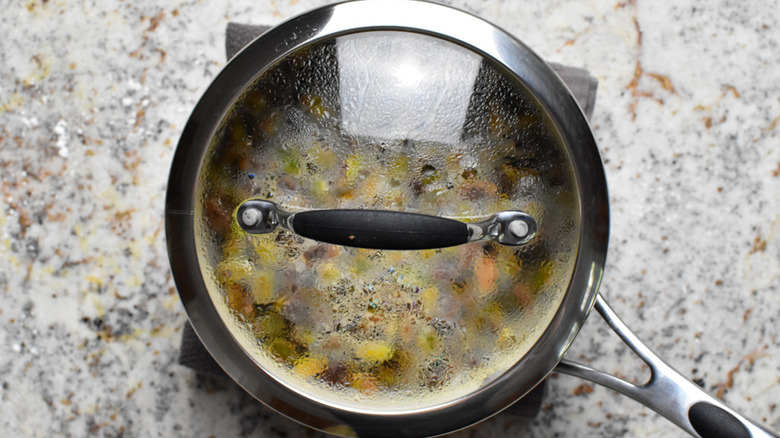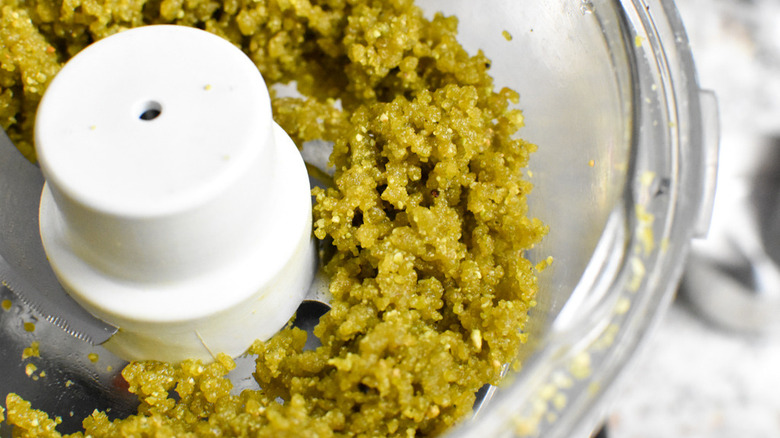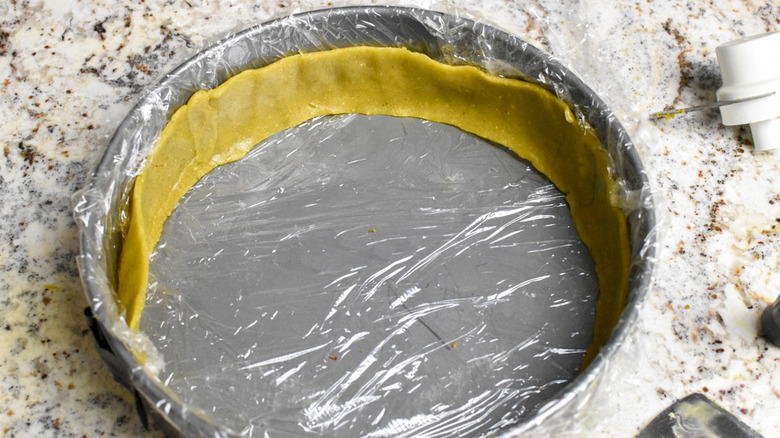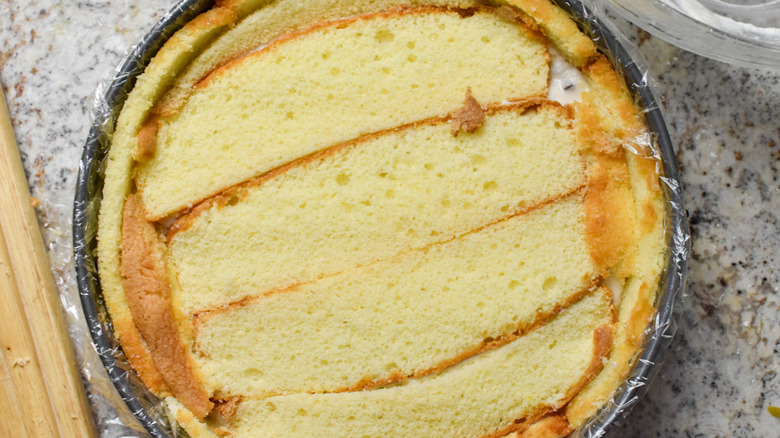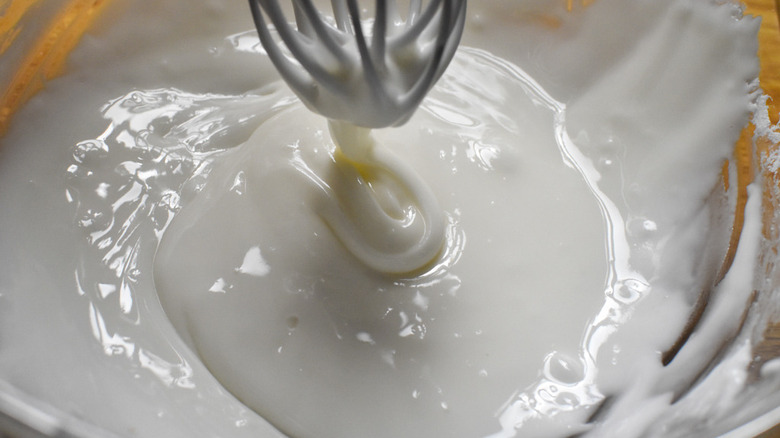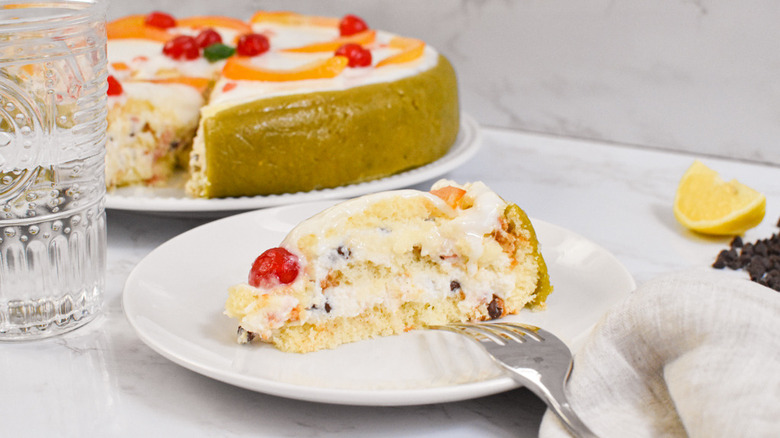Traditional Cassata Cake Recipe
If you are in the mood for a traditional cassata cake, then we have an excellent recipe for you! According to The Spruce Eats, cassata cake originated in Italy, where it's still. The first example of this cake dates back to the 10th century, but there are a lot of conflicting theories about its origins. But we do know for certain that this cake — with ricotta cheese, marzipan, pistachios, and candied fruit in the mix — is utterly delicious. This is, for many, one of the most unique cakes that you will ever have the pleasure of trying. Did we mention that it also often comes with semi-sweet chocolate chips? Yeah, it's pretty awesome.
Recipe developer Stephanie Rapone came up with a fantastic recipe that looks and tastes next-level good. She loves the recipe for a variety of reasons but one of them is due to the fact that it hits close to home in a very good way. "The ricotta filling reminds me of cannoli, which is one of our favorite desserts as a family," Rapone shares. Even if nostalgia isn't a factor for you here, the rich flavor and unique look of this classic cassata cake is still calling your name.
Gather the ingredients
The first thing you need to do is to gather up the ingredients needed for this recipe. You will need to get powdered sugar, whole milk ricotta, and vanilla bean paste to start. For a little bit of zest, add two lemons to your list. For a hint of sweetness, grab some semi-sweet chocolate chips and some chopped candied fruit to mix in with the ricotta. You'll also want some more visually striking candied fruit to top the cake. Here, Rapone used candied oranges and cherries.
The recipe also calls for a round sponge cake. "The already-made sponge can be purchased at Whole Foods or at most Italian bakeries (you should probably call ahead first to make sure they have it!)," Rapone says. That said, if you're feeling ambitious and want to make your own, this easy Victoria sponge cake would work well too. The remaining ingredients include shelled pistachios, marzipan, sugar, and water. Once you have everything gathered together, it's time to begin.
Sift the powdered sugar and mix ingredients
First, take out the powdered sugar and sift 2 cups to make sure that it's all of an even texture and there are no lumps. Once you've done that, take out one of your lemons and wash it well. Then, use a zester to zest the fragrant lemon rind into a bowl.
Grab another bowl and combine the sifted powdered sugar with the ricotta, vanilla bean paste, and lemon zest. Next, toss in the chocolate chips and ½ cup of the chopped candied fruit. Use a spatula to stir everything together and then move the bowl over to the side. Keep it close by, however, as you will need it shortly.
Make sugar mix and line a springform pan
Take out a small pan and add a cup of sugar followed by a cup of water and the juice from one lemon. Put the pan onto the stove and crank up the heat to medium-high. Continue cooking the mixture until the sugar melts completely, stirring to make sure that the ingredients are dissolving evenly. Take the pan off of the heat and set it to the side.
Get out a springform pan and line it with plastic wrap by crisscrossing two pieces and laying the wrap assembly into the bottom of the pan (making sure that the sides are covered, too). Next, take out the sponge cake and cut it into ¼ inch slices. Set those to the side as well. Now, the truth is that you won't need the cake or springform right away, but you'll be grateful that it's ready in just a few steps, we promise!
Boil water and add pistachios
Okay, now it's time to get back to the heat. Grab another pan and bring 2 cups of water to a boil. Once the water starts to bubble, toss in the pistachios. Then, put the lid on the pot and remove it from the heat.
Allow the pistachios to sit in their hot water bath for about 3 to 4 minutes before draining the water and placing the pistachios on a kitchen towel. Fold the towel over the top of the pistachios and rub them vigorously to get the skins off. Then, dig through the pistachios to find the greenest ones, as these look especially nice in the cake. Measure out ½ cup of the greenest skinless pistachios.
Blend the pistachios
Now, grab either a food processor or a high-powered blender and process the pistachios until they turn into a fine crumb. Then, add 1 or 2 tablespoons of the sugar syrup as you blend until paste forms.
Once you have got your paste, add the pistachio-sugar mixture to the marzipan. Use your hands to knead this into the marzipan and create a green paste. "I had to do some research for what makes a Cassata cake "traditional," says Rapone. "I thought, instead of going through the more extensive process of making homemade pistachio marzipan, I would try mashing up pistachios and marzipan, and it totally worked. I really love the flavor too, especially compared to traditional marzipan."
Roll out the marzipan
Grab a roller and roll out the marzipan to about ¼-inch thickness. Then, cut it into strips about 2 inches high and line the edges of the cake pan with the marzipan, piecing it together as you go so that there aren't any cracks and you have a cohesive ring.
Next, line the bottom of the pan with slices of sponge cake. Feel free to use some of the smaller pieces of cake to help fill in the gaps in the first layer, even breaking them apart to really ensure that there are no gaps and the cake fully covers the bottom of the springform pan. Add a layer of the sponge cake over the marzipan around the edges of the pan as well. Don't use all of the spongecake pieces (you should have plenty), as it will be built up in layers after this first step.
Brush the sugar syrup over the cake
Now, it's time to make use of your remaining sugar syrup. Brush it over the sponge cake in an even layer. Then, carefully spoon half of the ricotta over the now-syrupy sponge cake. Add another layer of sponge cake slices on top of this. This time, it's okay if there are any gaps. Then, layer on the remaining ricotta.
Cover the ricotta layer with more strips of sponge cake, then pull the pieces of plastic wrap hanging over the sides of the pan back and over the cake. If it doesn't cover your cake completely, simply add another layer. Place the cake in the fridge for at least 3 hours or overnight to set.
Make the cake's glaze
Once everything has set, it's time to make the glaze that will top your traditional cassata cake. Start by juicing the second lemon and then placing the juice aside.
Then, sift 2 ½ cups of powdered sugar. Begin to whisk the sugar and lemon juice together, adding a tablespoon of lemon juice at a time until it reaches a thick consistency. Essentially, you don't want the glaze to be runny, but you do want it to be spreadable and able to help the cake and toppings stick together.
Remove the cake from the fridge and enjoy
Take the cake from the fridge and pull off the top layer of plastic wrap. Then, place a plate over the cake and flip it over. Remove the outer ring of the springform pan and carefully remove the plastic wrap.
Then, spread the lemon glaze on the top of the cake. While the glaze is still wet, decorate it with pieces of candied fruit. "I had to order the prettier candied fruit for the top decorations on Amazon but read both Turkish and Italian important grocery stores will often have it," Rapone notes. As for the exact type of fruit you'll use here, that's really up to you. "We like the flavors of the cherries and pineapples," says Rapone, "and the look of orange peels (but end up picking them off since they are a little bitter)."
As for leftovers? Little could be easier than managing that. Simply wrap the remaining cake up again with plastic wrap and pop it back in the fridge, where it will be good for up to five days.
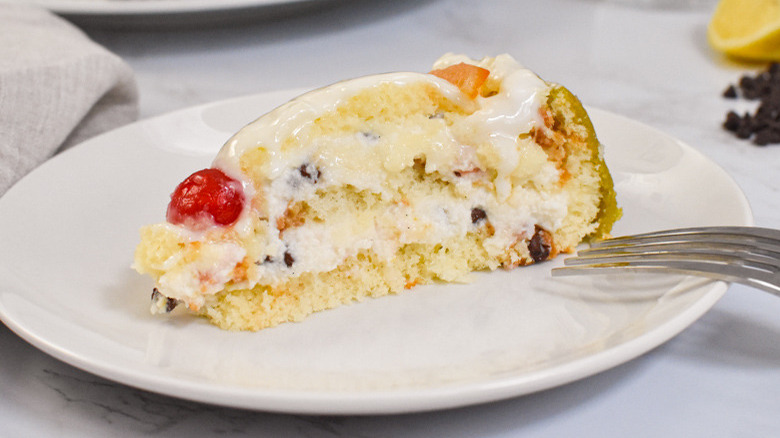
- 4 ¾ cups powdered sugar, divided
- 2 lemons, divided
- 30 ounces whole milk ricotta
- 1 teaspoon vanilla bean paste
- ⅔ cup mini semi-sweet chocolate chips
- ½ cup chopped candied fruit
- 1 cup sugar
- 1 cup water
- One 16-ounce round sponge cake
- ⅔ cup shelled pistachios
- 4 ounces marzipan
- Candied fruit for decorating
- Sift 2 ¼ cups powdered sugar.
- Wash and zest a lemon.
- Using a whisk, combine the powdered sugar, ricotta, vanilla bean paste, and lemon zest. Stir in the chocolate chips and chopped candied fruit. Set aside.
- Combine 1 cup sugar and 1 cup water, along with the juice from 1 lemon, in a small pan on the stove. Heat over medium-high heat until the sugar melts completely. Set this sugar syrup aside.
- Line a springform pan with plastic wrap.
- Cut the sponge cake into ¼" slices.
- Bring 2 cups of water to a boil. Once boiling, add the pistachios. Put the lid on the pot and remove it from the heat. Allow the pistachios to sit in the water for 3-4 minutes.
- Drain off the water and place the pistachios on a kitchen towel. Fold the towel over the top and rub the pistachios vigorously to remove the skins.
- Pick through the pistachios to find the greenest ones for ½ cup total.
- Place pistachios in a food processor or high-powered blender. Process until fine. Add 1-2 tablespoons of sugar syrup while blending, until paste forms.
- Using your hands, knead the pistachio paste into the marzipan.
- Roll out the marzipan to ¼-inch thickness. Cut into strips about 2 inches high. Line the sides of the cake pan with marzipan.
- Line the bottom and sides of the pan with the sliced sponge cake. Use smaller bits of cake to fill in gaps.
- Brush the sugar syrup over the sponge cake. Carefully spoon half ricotta mixture over the sponge cake.
- Add another layer of sponge cake, then the rest of the ricotta. Cover the ricotta with the remaining strips of sponge cake.
- Pull up the overhanging plastic wrap over the cake. Place in the fridge for at least 3 hours or overnight.
- Make the top glaze. Juice the second lemon and set it aside.
- Sift 2 ½ cups powdered sugar. While whisking, add 1 tablespoon of the lemon juice. Then, continue to add ½ teaspoon at a time until it reaches a very thick consistency.
- Take the cake out of the fridge and remove the top layer of plastic wrap. Place a plate on the cake and flip it over. Remove the springform ring, then remove the plastic wrap.
- Carefully spread the lemon glaze on the top of the cake. While the glaze is still wet, decorate with candied fruit.
| Calories per Serving | 1,293 |
| Total Fat | 39.0 g |
| Saturated Fat | 17.4 g |
| Trans Fat | 0.0 g |
| Cholesterol | 200.8 mg |
| Total Carbohydrates | 218.7 g |
| Dietary Fiber | 4.3 g |
| Total Sugars | 160.6 g |
| Sodium | 353.6 mg |
| Protein | 27.1 g |
